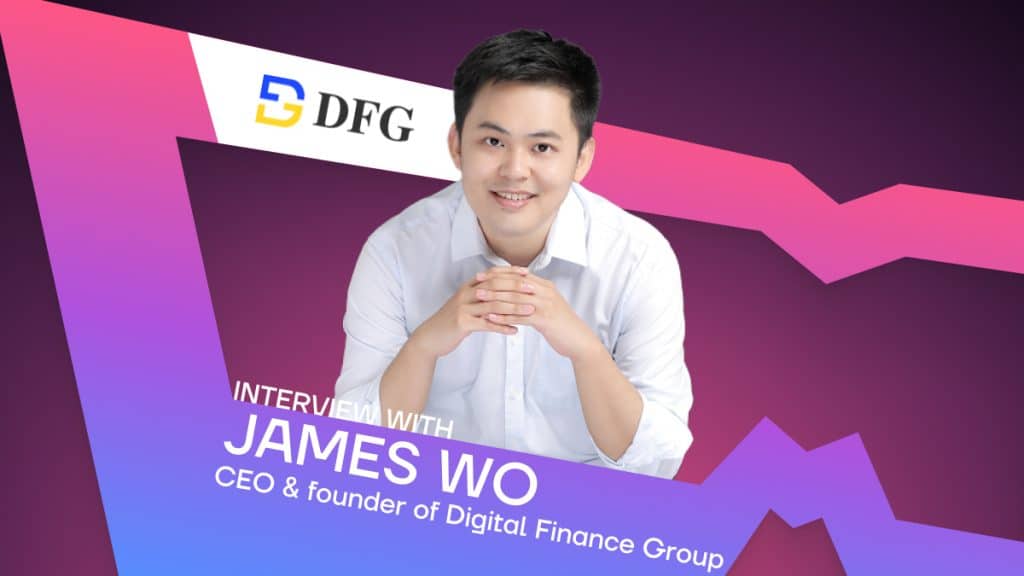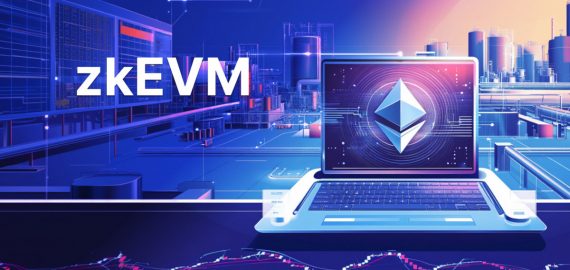Digital Finance Group Founder James Wo Talks Challenges and Opportunities in the World of Blockchain Investing



Founded in 2015 by James Wo, Digital Finance Group (DFG) has made a name for itself by investing in promising blockchain solutions and supporting the growth of underrated but high-value companies that have the potential to become industry behemoths.
With his investment background and a keen eye for promising assets, Wo was introduced to digital assets like Bitcoin and Ethereum around 2013-2014. He poured himself into the crypto market on an individual level and leveraged his knowledge of statistics to analyze assets that were not yet considered valuable investments. After gaining confidence in his practice, Wo founded DFG with a long-term vision of supporting companies that would become industry behemoths years later.
Following DFG’s recent investment in Ledger’s $108M Series C extension round, we catch up with Wo to discuss his approach to investing in promising solutions, how regulatory frameworks will impact the crypto industry, and his thoughts on the current crypto market.
What piqued your interest in the crypto/web3 space, and where did you first hear about it?
While I was in the final years of my bachelor’s degree at Fudan University Shanghai, I came across several students and friends that told me about Bitcoin and how it was a revolutionary idea as a currency, and how it could be the next financial revolution. In the beginning, I researched it out of curiosity, but I soon ended up going down the rabbit hole and gathered my savings to allocate a substantial part of them into acquiring BTC. This gave me great returns, and I was hooked.
As the CEO and founder of Digital Finance Group (DFG), can you tell us about your investment philosophy and how you identify promising projects to invest in the digital assets space?
First, we always insist on long-term investment and stick to it in the volatile market environment. Secondly, we take strict risk management. Liquid assets, such as stablecoins, BTC, and ETH, make up a large part of our portfolios, and we never participate in leverage or lending. Last but not least, we have an independent investment research team, which will conduct comprehensive and independent research on each invested project and refuse to follow the trend of investment.
With over $1B in AUM, DFG has become a major player in the crypto investment space. What are some of the most successful investments that DFG has made, and what factors contributed to their success?
The recent investments I would like to share are Shardeum, Astar Network, and Ledger. Shardeum and Astar Network are both Layer1 projects, and I think they have a good future ahead of them. Astar has already become the most popular Layer1 in the Japanese market, with a deep background in the traditional industry, strong IPs and gaming project resources, and a very large ecology; Ledger hardware wallet has always had a good reputation and a stable user base, and there is no doubt that it will develop into a leading project in web3 infrastructure.
Why did DFG decide to invest in Ledger’s latest investment round? What drew you to it, and what potential do you see for it in the crypto and Web3 space?
As a veteran hardware wallet manufacturer, Ledger is one of the top-selling hardware wallets on the market, which has accumulated a large user base and has successfully protected 20% of the world’s digital currency and assets and 30% of the world’s NFT assets. Ledger has successfully proven the value of its technology and products to the market, and the wallet has never experienced a hack or other security incident since its launch. We believe that with the new funding injection, Ledger will further expand its product line, improve the user experience, realize its global strategy, and ultimately become a leader in the infrastructure track in the cryptocurrency and web3 space.
You’ve been an early investor in blockchain ecosystems like Polkadot and Kusama networks. Can you share any insights into how you identified these opportunities early on?
A long time ago, we were aware of the scalability issues of Ethereum or the general layer-1 projects. We followed and researched new technologies and products in the market and found that what attracted us most to Polkadot is that it proposes an advanced “interoperability” framework that can connect multiple disparate blockchains into a unified, scalable network. This means that Polkadot can actually enable different blockchain networks to communicate with each other. We all know that most of the early Layer 1 networks, such as Bitcoin and Ethereum, could only complete transactions on their native networks, and each had some functional limitations. Once true interoperability and cross-chain communication is achieved, it will open up unprecedented new possibilities for crypto applications.
With so many new blockchain and crypto projects launching all the time, how do you evaluate the potential of new blockchain projects, and what criteria do you look for when deciding whether to invest?
Our research team will conduct a comprehensive and independent analysis of each project. The main criteria of our investment decision are the following three points:
- Background of the founders and core team. We will conduct in-depth due diligence on the background of the founders and core leaders to judge the core team’s ability to deliver the product.
- Key innovation. The project needs to have certain technical or product innovation points in a track, not just creating hype.
- Tokenomics. The success of many blockchain projects depends on healthy tokenomics, which determines the sustainability of the project development.
How has your investment thesis evolved as the crypto market matures, and what types of projects are you most excited to invest in right now?
DFG’s investment philosophy has always been very diversified. We invest in traditional equity projects but also in competitive crypto underlying infrastructure or early-stage new paradigm dApp applications, and our investment theory will continue to iterate as the industry shifts from bull to bear. Our current preferred project types are:
- Infrastructure projects. Infrastructure not only has higher valuation growth space but also has higher requirements for team technical capabilities.
- Projects with compliance and financial attributes. Industry regulation is becoming more and more mature, and compliance is a necessary condition for the future development of the project, in addition with financial attributes can bring more effective user growth and value capture.
- Unlimited types but in line with DFG investment and value philosophy. For example, projects with innovative business models and excellent tokenomics.
Many VCs have said that the bear market is the best time to invest in crypto and web3 at a discount for potentially greater returns when the bull run resumes. Other than this reason, why do you think now is the best time to invest and what are some of the most exciting opportunities you see in this space?
The new NFT application on Bitcoin and its expansion on Layer 2, the finalization of another hard fork upgrade of Ethereum, and the sharding are just around the corner, indicating the new paradigm of these leading projects in the crypto industry has been fully proven, and the future is unlimited. DFG’s bullish projects include Sharderum, Astar, Render Network, etc. These are all excellent infrastructure projects, and of course, we will continue to lay out in Layer 1 and 2 and DeFi, GameFi, etc., waiting for the next bull market.
Besides simply pouring capital into crypto and web3 startups, how can investors effectively and actively support the development of the crypto ecosystem?
Investors are one of the core builders of the crypto industry, and financial support is only part of the resources they bring to the table. We believe that an interactive investment service model can help these startups to grow.
After investing in a project, institutions should continue to follow its development at all stages, like participating in trialing new products and applications of the project, engaging in core eco-building activities such as network testing, token staking, liquidity supplying, and community governance of the blockchain project, and providing professional advice, suggestions, and related support to help the project expand its community and business. Crypto startup teams are often small in size, and they need not only financial support but also continuous and long-term support in their business growth, business model, and market expansion.
What are some of the biggest challenges VCs are facing in the crypto industry right now, and how do you see them being addressed over the next few years?
First, the entire market is in a crypto winter. The overall investment environment is weak due to events such as the global pandemic, macroeconomics and black swan events in the crypto industry. Although there are signs of recovery into 2023, the market as a whole has not yet rebounded so far, and the steps of new projects have slowed down significantly, with fewer good investment targets.
However, I think we will soon be able to cross this winter and may see the arrival of a crypto bull market next year when more new projects and good teams emerge.
Second, many tracks are currently lacking breakthrough use cases, which affects the sustainability of projects. For example, NFT lacks adoption and needs to create real use cases to make a breakthrough, while GameFi lacks a healthy business model to consistently attract enough users to participate. In the next bull market, perhaps NFT and GameFi will have new use cases and models.
How do you think regulatory frameworks will evolve for crypto and blockchain projects, and what impact do you think this will have on the industry as a whole?
There are currently two types of regulation of crypto and blockchain projects overall: on the one hand, the US has tightened regulation of the crypto industry due to the FTX incident. This appears to be restrictive to the industry in the short term, but it is beneficial in the long term, as people are more willing to trust decentralized platforms (rather than centralized institutions), and it will force better terms on the regulatory side. On the other hand, many emerging markets are showing a friendly attitude towards the crypto industry, such as Japan, Dubai, Singapore, (Hong Kong), India, Indonesia, and Europe. Overall, while we are seeing regulatory tightening in the US, from a global perspective, it is more positive support.
What advice do you have for investors who are just getting started in the crypto space?
First, don’t do leverage or lending investment, then you can survive a black swan event; Secondly, for stable fundamental projects, insist on a long-term value investment, such as BTC or ETH. Thirdly, DYOR. You must do full due diligence on investment projects and get your own investment philosophy rather than blindly believe large projects or large institutions.
What are your thoughts on the current state of the crypto market and where it’s headed in the next few years?
After the bubble and winter of 2022, we see the whole industry tending to be more rational and calm. At the same time, we can also see that the crypto industry has made a lot of substantial progress compared to the bubble period in 2017, such as the merger of Ethereum, the boom of DeFi applications, etc., which have really generated a lot of practical applications and value.
Overall, the Ethereum ecosystem is still healthy, and Bitcoin is relatively stable. I think there are still more possibilities for Bitcoin and Ethereum in the secondary market in the next few years, and maybe we will see the beginning of the bull market next year. In addition, there will be more Layer1 and Layer2 innovations and competition coming up.
Any other crypto/web3-related industry issue you would like to talk about?
I can say that we’re still early in this industry as the market cap of BTC is less than 5% of the gold market cap. You can only find two legit ways to become rich in the crypto space:
- Build a solid project with people who actually use your product and keep working on it, no matter the bear market or bull market.
- Buy valuable assets like BTC, ETH, and DOT and keep holding them till the end.
Read more:
- Fireblocks’ Amy Zhang Talks Blockchain, AI and the Metaverse at Hong Kong Web3 Festival 2023
- Scott Lawin, CEO of Candy Digital, on Navigating the Post-Boom NFT Landscape
- OKX Ventures Partner Jeff Ren Hints at Future Metaverse-Related Announcements
Disclaimer
In line with the Trust Project guidelines, please note that the information provided on this page is not intended to be and should not be interpreted as legal, tax, investment, financial, or any other form of advice. It is important to only invest what you can afford to lose and to seek independent financial advice if you have any doubts. For further information, we suggest referring to the terms and conditions as well as the help and support pages provided by the issuer or advertiser. MetaversePost is committed to accurate, unbiased reporting, but market conditions are subject to change without notice.
About The Author
Cindy is a journalist at Metaverse Post, covering topics related to web3, NFT, metaverse and AI, with a focus on interviews with Web3 industry players. She has spoken to over 30 C-level execs and counting, bringing their valuable insights to readers. Originally from Singapore, Cindy is now based in Tbilisi, Georgia. She holds a Bachelor's degree in Communications & Media Studies from the University of South Australia and has a decade of experience in journalism and writing. Get in touch with her via [email protected] with press pitches, announcements and interview opportunities.
More articles

Cindy is a journalist at Metaverse Post, covering topics related to web3, NFT, metaverse and AI, with a focus on interviews with Web3 industry players. She has spoken to over 30 C-level execs and counting, bringing their valuable insights to readers. Originally from Singapore, Cindy is now based in Tbilisi, Georgia. She holds a Bachelor's degree in Communications & Media Studies from the University of South Australia and has a decade of experience in journalism and writing. Get in touch with her via [email protected] with press pitches, announcements and interview opportunities.

















































